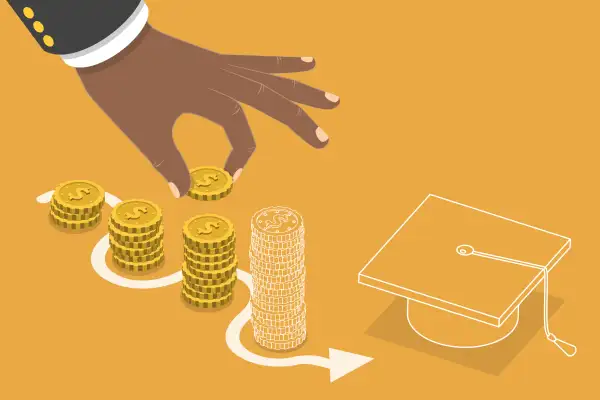Here's the Latest on Student Loans, Refinance Rates and More for June 18, 2020

High school graduation ceremonies may be over, but hundreds of colleges are still looking for applicants to fill out empty spots. To sweeten the deal, some are even offering tuition freezes or discounts, to boost enrollment.
With financial aid packages falling short, and the extra $600 in weekly unemployment benefits ending next month, those deals may be attractive to families. Nearly 70% of parents in a recent survey said they worry about how they’ll pay for college.
Even before the pandemic and recession, paying for college was no easy feat: Tuition at public four-year colleges now averages more than $10,000 a year for in-state students, and that doesn’t include housing, books, and other living expenses. Nearly two-thirds of bachelor’s degree recipients have to use loans to help cover the bill.
This year, some students will be forced to rely on student loans more heavily to afford to go to college. Others may opt to attend a less expensive school or sit out a year to try to avoid debt.
Money’s roundup of news and interest rates can guide you through your decision.
Daily College News and Student Loan Update
With reopening plans still uncertain, a long list of colleges are still accepting applications for the fall semester. According to the National Association for College Admission Counseling (NACAC), more than 750 colleges still have space for freshmen students next fall — a 49% increase compared to last year.
That’s good news for students who may want to change their enrollment plans in light of coronavirus campus closures or changes in their household finances. Recent surveys suggest that could be a significant number fo students. Over one-third of college-bound seniors in one survey said that their post-graduation plans have changed. Some are considering attending schools closer to home or community colleges to save money.
Traditionally, selective colleges across the country require applicants to submit deposits by May 1 to hold their spot for the upcoming school year. This year, given the extraordinary circumstances, many colleges delayed those deadlines, and hundreds of others have reopened their admissions deadline for the 2020-2021 school year. Some even accept applications until August.
To lure more students into enrollment, institutions like Utica College, Western Michigan University, St. Mary’s University, and the University of Nebraska, among many others, are offering a series of temporary tuition freezes or discounts to make their degrees more accessible amid the pandemic.
“We understand that in these uncertain times, many Nebraskans are rethinking every dollar,” said Ted Carter, president of the Nebraska University system, in a statement. “We want students and families to know that their University is here for them, that we want them as part of our family, and that we’re doing everything we can to keep the promise of a college education within reach, no matter what their circumstance.” This fall, the University of Nebraska will offer free tuition for Nebraskan students whose family income is $60,000 or less.
If you’re among those who don’t want to miss out on this fall semester, and are looking for options, you can check the NACAC’s annual list of colleges that are still accepting students. You can also "visit" the schools you’re interested in by checking out one of YouVisit’s 360 virtual tours.
Current Federal Rates and What to Know
If you need to borrow for college, federal student loans should be the first option you explore, as they are easy to access. They don’t require credit checks and nearly any student in good academic standing can get them. Federal loans also offer more flexible repayment options than private loans. Annual borrowing limits range between $5,500 to $12,500, depending on your school year and dependency status.
Another great thing about federal student loans is that they take out the guesswork of figuring out your interest rate, since all applicants get the exact same pre-established rate for that particular year on that particular loan they applied for.
Interest rates for federal student loans are set every year using the results from the 10-year Treasury note auction each May. Those rates affect all federal student loans disbursed between July 1and June 30 of the upcoming year.
As a result of the economic fallout caused by the coronavirus pandemic, interest rates have fallen to record lows, which means that federal student loans for the upcoming 2020-2021 academic year will have the lowest rates in over a decade.
Here’s a breakdown of both the current and upcoming interest rates:
Federal Student Loan Rates: 2019-2020
- Undergraduate Direct Subsidized and Unsubsidized loans - 4.53%
- Graduate or Professional Unsubsidized loans - 6.08%
- Direct PLUS loans - 7.08%
Federal Student Loan Rates: 2020-2021
- Undergraduate Direct Subsidized and Unsubsidized loans - 2.75%
- Graduate or Professional Unsubsidized loans - 4.3%
- Direct PLUS loans - 5.3%
Compared to last year, students will be paying 1.78% less on interest, which could save you hundreds to thousands of dollars over the life of the loan. For example, if you took an undergraduate loan last year for $7,500 with a 4.53% interest rate, and a standard 10-year repayment plan, you will be paying around $1,840 worth of interest. If you take out that same loan this year, with the same repayment plan, but with the 2.75% interest rate, you’ll only be paying $1,087 worth of interest.
Private Student Loan Rates
Private student loans are an option to bridge the financial gap when you’ve exhausted all other types of financial aid avenues, including federal loans.
Martin Lynch, compliance manager and director of education at Cambridge Credit Counseling Corp.,says students should only use private loans as a last resort, and they should be as conservative as you possibly can with the amount you wish to borrow, and he suggests to only use them as a last resort.
“Always max out the federal loans first,” Lynch, who also serves the Financial Counseling Association of America’s board of directors, says.
Unlike federal loans, which only have fixed interest rates, private student loans offer both fixed and variable interest rates.The specific rate you get will depend on your (or your parents’) creditworthiness. With a fixed rate, payments stay the same over the life of the loan, while with a variable rate your payments may fluctuate based on current market conditions.
Most private student loans currently use the 3-month London Interbank Offered Rate, commonly known as “LIBOR,” as their baseline to set their interest rate ranges. The LIBOR usually follows the federal funds rate closely.
Last week, the Federal Reserve announced that the federal funds target rate will remain close to zero possibly until 2022. In other words, it is unlikely private loan rates will increase in the near future.
Here are today’s private student loan rates for undergraduate students from some of the nation’s largest lenders:
Wells Fargo
- Fixed: 4.78% - 10.97%
- Variable: 2.93% - 9.70%
SoFi
- Fixed: 4.73% - 11.46%
- Variable: 1.30% - 10%
Sallie Mae
- Fixed: 4.74%- 11.85%
- Variable: 1.25% - 9.44%
Discover
- Fixed: 4.49% - 12.39%
- Variable: 1.49% - 11.49%
College Ave
- Fixed: 4.64% - 13.24
- Variable: 1.74% - 12.23%
Refinancing Student Loans
If you already have private student loans, there’s probably never been a better time to refinance. With benchmark interest rates so low, your chances of securing a better interest rate are extremely high, especially if you have a good credit score of 720 or over, and a steady source of income.
Refinancing your private student loans can help you save money by lowering your interest rate. In some cases, you can also lower your monthly payment. If you have more than one loan, this can also be an option to help you consolidate multiple payments into a single one, plus it can help you release a cosigner.
When it comes to federal student loans, refinancing may not be the best option. “You would lose some of the benefits, like access to forgiveness programs,” says Brenda Hicks, director of financial aid at Southwestern College in Winfield, Kansas.
“It's really tough to beat the federal student loan rate, even if it's an unsubsidized loan. Federal student loans are at 2.75% right now, and that's incredible. I don't think you're going to be able to get a better rate than that, unless you have an incredibly good credit or a cosigner that's amazing,”she adds. However, Hicks says that for private or parent loans, refinancing could be a good move because rates in the private sector are at all-time lows.
Let’s say you currently owe $10,000 on a private student loan with a 9% interest rate and 5 years remaining on the repayment term. With that loan, you’ll end up paying the balance of $10,000, in addition to $2,455 worth of interest.
If you refinance that $10,000 with the same 5-year term, but with a 4% interest rate, you’ll end up paying less each month and only $1,050 worth of interest. In this case, refinancing saved you $1,400.
Here are today’s refinancing rates from some of the best-known refinance companies:
CommonBond
- Fixed: 3.2% - 6.43%
- Variable: 3.2% - 6.08%
Earnest
- Fixed: 3.45% - 6.68%
- Variable: 2.64% - 6.68%
SoFi
- Fixed: 3.20% - 6.44%
- Variable: 2.99% - 6.44%
More from Money:
With Interest Rates Near All-Time Lows, Here’s What to Know About Refinancing Your Student Loans
A Mistake Caused Credit Scores to Drop for Tons of Student Loan Borrowers. Here's How to Fix Yours
